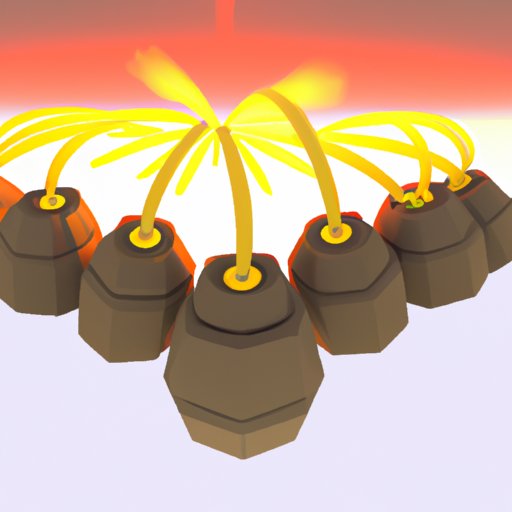Introduction
A nuclear weapon is any device that uses the energy released by nuclear reactions to create an explosion. While they are commonly referred to as “nukes” or “bombs,” they can also be missiles, artillery shells, torpedoes, and other devices. In this article, we will explore how a nuke works, including the different types of nuclear weapons, their components, the mechanics of a nuclear explosion, and the process of nuclear fission and fusion.
Explaining the Different Types of Nuclear Weapons
There are three main types of nuclear weapons: fission bombs, fusion bombs, and hybrid bombs. Fission bombs, also known as atomic bombs, use a chain reaction of nuclear fission to create an explosive force. Fusion bombs, also known as thermonuclear bombs, use the energy released by nuclear fusion to create an even more powerful explosion than a fission bomb. Finally, hybrid bombs combine fission and fusion reactions for an even greater destructive force.
Discussing the Components of a Nuclear Weapon
A nuclear weapon consists of three main components: fissile material, a detonator, and a triggering mechanism. Fissile material, such as uranium-235 or plutonium-239, is the material that undergoes a chain reaction when bombarded with neutrons. The detonator sets off the chain reaction of nuclear fission or fusion. Finally, the triggering mechanism is responsible for arming the weapon and initiating the detonation.
Examining the Mechanics of a Nuclear Explosion
When a nuclear weapon is detonated, a chain reaction occurs in which the nuclei of the fissile material split into smaller atoms, releasing energy in the form of heat, light, and radiation. This energy is what causes the explosion. The shockwaves created by the blast can reach up to several miles away, and the fallout from the explosion can spread radioactive particles far and wide.

Describing the Process of Nuclear Fission and Fusion
Nuclear fission is the splitting of a heavy atom, such as uranium or plutonium, into two or more lighter atoms. When a neutron strikes the nucleus of a uranium or plutonium atom, it splits into two smaller atoms, releasing energy in the form of heat and radiation. Nuclear fusion, on the other hand, is the combining of two or more light atoms, such as hydrogen, to form a heavier atom. This process also releases energy in the form of heat and radiation.

Outlining the History of Nuclear Weapons Development
The development of nuclear weapons began in the 1930s, when scientists first discovered how to split the atom. During World War II, the Manhattan Project sought to develop an atomic bomb for the United States. After the war, the Cold War saw a rapid expansion in the development of nuclear weapons by both the United States and the Soviet Union. Since the end of the Cold War, there has been a gradual reduction in the number of nuclear weapons, although some countries continue to pursue their development.

Assessing the Impact of Nuclear Weapons on Society
The use of nuclear weapons has raised numerous humanitarian concerns, due to the devastating effects they can have on people and the environment. There are also economic considerations, as the cost of maintaining and developing nuclear weapons is significant. Finally, there are political implications, as the possession of nuclear weapons can give a country greater influence in international affairs.

Analyzing the Current Nuclear Arms Race
Despite decades of efforts to reduce the number of nuclear weapons, many countries still possess them. International agreements, such as the Non-Proliferation Treaty, seek to limit the proliferation of nuclear weapons. However, modern threats, such as terrorism, have led to renewed fears of a nuclear arms race. In the future, further developments in nuclear technology could lead to new types of weapons with even greater destructive power.
Conclusion
In summary, nuclear weapons are powerful devices capable of immense destruction. They consist of fissile material, a detonator, and a triggering mechanism, and work through a chain reaction of fission or fusion. Their development has been shaped by the history of the Cold War and the current arms race. Finally, their use has raised numerous humanitarian, economic, and political concerns. Understanding how a nuke works and its implications is essential to ensure their safe and responsible use.
(Note: Is this article not meeting your expectations? Do you have knowledge or insights to share? Unlock new opportunities and expand your reach by joining our authors team. Click Registration to join us and share your expertise with our readers.)
